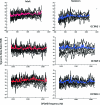The breaking of cochlear scaling symmetry in human newborns and adults
- PMID: 21568413
- PMCID: PMC3108391
- DOI: 10.1121/1.3569737
The breaking of cochlear scaling symmetry in human newborns and adults
Abstract
Scaling symmetry appears to be a fundamental property of the cochlea as evidenced by invariant distortion product otoacoustic emission (DPOAE) phase above ∼1-1.5 kHz when using frequency-scaled stimuli. Below this frequency demarcation, phase steepens. Cochlear scaling and its breaking have been described in the adult cochlea but have not been studied in newborns. It is not clear whether immaturities in cochlear mechanics exist at birth in the human neonate. In this study, DPOAE phase was recorded with a swept-tone protocol in three, octave-wide segments from 0.5 to 4 kHz. The lowest-frequency octave was targeted with increased signal averaging to enhance signal-to-noise ratio (SNR) and focus on the apical half of the newborn cochlea where breaks from scaling have been observed. The results show: (1) the ear canal DPOAE phase was dominated by the distortion-source component in the low frequencies; thus, the reflection component cannot explain the steeper slope of phase; (2) DPOAE phase-frequency functions from adults and infants showed an unambiguous discontinuity around 1.4 and 1 kHz when described using two- and three-segment fits, respectively, and (3) newborns had a significantly steeper slope of phase in the low-frequency portion of the function which may suggest residual immaturities in the apical half of the newborn cochlea.
Figures







References
-
- Abdala, C., Kalluri, R., Dhar, S., Rogers, A., and Luckovich, S. (2011). “Level dependence of DPOAE phase is attributed to component mixing,” in Poster Presented to the 34th Midwinter Meeting of the Association for Research in Otolaryngology, February 2011, #101, Baltimore, MD.
Publication types
MeSH terms
Grants and funding
LinkOut - more resources
Full Text Sources

